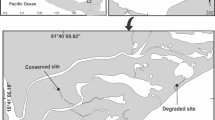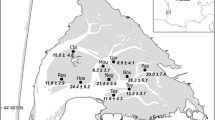Abstract
The Hackensack Meadowlands District is a large heavily degraded, brackish marsh system in the urbanized northeastern region of New Jersey, USA. Six study sites were used, three of which were restored (Mill Creek, Skeetkill Creek and Vince Lombardi), and three others were unrestored (Richard DeKorte Park, Cedar Creek and Kingsland Creek). Highly significant differences were found with respect to snail abundance and gill parasite abundance. In the three restored sites, significantly more Littoridinops tenuipes were found, and Fundulus heteroclitus had significantly more digenean trematode metacercariae gill infections than at unrestored sites. As habitat quality improves following restoration, the number of suitable digenean trematode parasite hosts multiplies as substrate for benthic invertebrates (first intermediate host) increases and usage by other species, such as Fundulus spp. (second intermediate host), is encouraged, which then attracts more wading birds (definitive host). Though the restoration process enhances trophic complexity, including primary consumers (gastropods), secondary consumers (fish) and tertiary consumers (wading birds), and ultimately parasite diversity, restoration also helps facilitate parasite life cycles.




Similar content being viewed by others
References
Coleman FC, Travis J (1998) Phenology of recruitment and infection patterns of Ascocotyle pachycystis, a digenean parasite in the sheepshead minnow, Cyprinodon variegatus. Environ Biol Fishes 51:87–96. doi:10.1023/A:1007341322937
Coyner DF, Spalding MG, Forrester DJ (2003) Influence of treated sewage on infections of Eustrongylides ignotus (Nematoda:Diotophymatoidea) in eastern mosquitofish (Gambusia holbrooki) in an urban watershed. Comp Parasitol 70(2):205–210
Curtis LA (2005) Movements of Ilyanassa obsoleta (Gastropoda) on an intertidal sandflat. Mar Biol 148:307–317. doi:10.1007/s00227-005-0042-I
Davis GM, Mazurkiewicz M, Mandracchia M (1982) Spurwinkia: morphology, systematics, and ecology of a new genus of North American Marshland Hydrobiidae (Mollusca: Gastropoda). Proc Acad Nat Sci Philadelphia 134:143–177
Dawkins R, Krebs JR (1979) Arms races between and within species. Proc R Soc Lond B 205:489–511
Dezfuli BS, Giari L, Konecny R, Jaeger P, Manera M (2003) Immunohistochemistry, ultrastructure and pathology of gills of Abramis brama from Lake Mondsee, Austria, infected with Ergasilus sieboldi (Copepoda). Dis Aquat Organ 53:257–262
Erwin RM (1987) The use of natural vs man-modified wetlands by shorebirds and waterbirds. Colonial Waterbirds 9:137–138
Ferren WJ, Fiedler PL, Leidy A, Lafferty KD (1995) Wetlands of the central and southern California coast and coastal watersheds: a methodology for their classification and description. Environmental Protection Agency, Region IX, V1-1-49, San Francisco, CA
Figuerola J, Green AJ (2000) Haematozoan parasites and migratory behaviour in waterfowl. Evol Ecol 14:143–153. doi:10.1023/A:1011009419264
Fredensborg BL, Mouritsen KN, Poulin R (2006) Relating bird host distribution and spatial heterogeneity in trematode infections in an intertidal snail—from small to large scale. Mar Biol 149:275–283. doi:10.1007/s00227-005-0184-1
Galaktionov KV (1996) Life cycles and distribution of seabird helminths in arctic and sub-arctic regions. Bull Scand Soc Parasitol 6:31–49
Hechinger RF, Lafferty KD (2005) Host diversity begets parasite diversity: bird final hosts and trematodes in snail intermediate hosts. Proc R Soc Lond B 272:1059–1066. doi:10.1098/rsp.2005.3070
Hoffman GL (1999) Parasites of North American freshwater fishes. Cornell University Press, Ithaca
Holmes JC (1979) Parasite populations and host community structure. In: Holmes JC (ed) Host parasite interfaces. London, Academic Press, pp 27–46
Hudson PJ (1999) Birds and their parasites: victims of infection or fashion? Parasitol Today 15(1):4–5
Hudson PJ, Dobson AP, Lafferty KD (2006) Is a healthy ecosystem one that is rich in parasites? Trends Ecol Evol 21(7):381–385. doi:10.1016/j.tree.2006.04.007
Huspeni TC, Lafferty KD (2004) Using larval trematodes that parasitize snails to evaluate a saltmarsh restoration project. Ecol Appl 14(3):795–804
Huxhma M, Raffaelli D, Pike A (1993) The influence of Cryptocotle lingua infections on the survival and fecundity of Littorina littorea: an ecological approach. J Exp Mar Biol Ecol 168:223–238
Jimenéz-García MI, Vidal-Martínez VM (2005) Temporal variation in the infection dynamics and maturation cycle of Oligogonotylus manteri (Digenea) in the cichlid fish, ‘Cichlasoma’ urophthalmus, from Yucatán, México. J Parasitol 91(5):1008–1014
Johnson PTJ, Chase JM (2004) Parasites in the food web: linking amphibian malformations and aquatic eutrophication. Ecol Lett 7(7):521–526. doi:10.1111/j.1461-0248.2004.00610.x
Joklea J, Lively CM (1995) Spatial variation in infection by digenetic trematodes in a population of fresh water snails (Potamopyrgus antipodarum). Oecologia 103:509–517. doi:10.1007/BF00328690
Lafferty KD (2002) Interspecific interactions in trematode communities. In: Lafferty KD (ed) The behavioural ecology of parasites. CABI Publishing, New York, pp 153–170
Lafferty KD, Dobson AP, Kuris AM (2006) Parasites dominate food web links. Proc Natl Acad Sci USA 103(30):11211–11216. doi:10.1073/pnas.0604755103
Lafferty KD, Morris AK (1996) Altered behavior of parasitized killifish increases susceptibility to predation by bird final hosts. Ecology 77(5):1390–1397
LaSalle MW, Landin MC, Sims JG (1991) Evaluation of the flora and fauna of Spartina alterniflora marsh established on dredged material in Winyah Bay, South Carolina. Wetlands 11:191–208
Levri EP (1999) Parasite-induced change in host behavior of a freshwater snail: parasitic manipulation or byproduct of infection? Behav Ecol 10(3):234–241
McNeil R, Diaz MT, Villeneuve A (1994) The mystery of shorebird over-summering: a new hypothesis. Ardea 82:143–152
Miltner RJ, Ross SW, Posey MH (1995) Influence of food and predation on the depth distribution of the juvenile spot (Leiostomus xanthurus) in tidal marshes. Can J Fish Aquat Sci 52:971–982
Møller AP, Erritzøe J (1998) Host immune defence and migration in birds. Evol Ecol 12:945–953. doi:10.1023/A:1006516222343
Natural_Heritage (2004) Natural Heritage Endangered Species Program. Massachusetts Division of Fisheries & Wildlife, Coastal Marsh Snail (Littoridinops tenuipes). June, 2006 http://www.state.ma.us/dfwele/dfw/nhesp
Posey MH, Alphin TD, Powell CM (1997) Plant and infaunal communities associated with a created marsh. Estuaries 20(1):42–47
Probst S, Kube J (1999) Histopathological effects of larval trematode infections in mudsnails and their impact on host growth: what causes gigantism in Hydrobia ventrosa (Gastropoda: Prosobranchia)? J Exp Mar Biol Ecol 238(1):49–68
Rozas LP, Reed DJ (1993) Nekton use of marsh-surface habitats in Louisiana (USA) deltaic salt marshes undergoing submergence. Mar Ecol Prog Ser 96:147–157
Rozsa L (1992) Points in question endangered parasite species. Int J Parasitol 22(3):265–266
Santiago Bass C, Khan S, Weis JS (2007) Morphological changes to the gills of killifish associated with severe parasite infection. J Fish Biol 71:920–925. doi:10.1111/j.1095–8649.2007.01532.x
Smith NF (2001) Spatial heterogeneity in recruitment of larval trematodes to snail intermediate hosts. Oecologia 127:115–122
Spelke JA, Fell PE, Helvenston L (1995) Population structure, growth and fecundity of Melampus bidentatus (Say) from two regions of a tidal marsh complex in Connecticut. Nautilus 108(2):42–47
Talbot CW, Able KW (1984) Composition and distribution of larval fishes in New Jersey high marshes. Estuaries 7:434–443
Thomas F, Cezilly F, De Meeus T, Crivelli A, Renaud F (1997) Parasitism and ecology of wetlands: a review. Estuaries 20(3):646–654
Thompson FG (1968) The aquatic snails of the Family Hydrobiidae of peninsular Florida. University of Florida Press, Gainesville
Windham L, Lathrop RG Jr (1999) Effects of Phragmites australis (Common Reed) invasion on aboveground biomass and soil properties in brackish tidal marsh of the Mullica River, New Jersey. Estuaries 22(4):937–935
Zampella RA, Bunnell JF (1998) Use of reference-site fish assemblages to assess aquatic degradation in Pinelands streams. Ecol Appl 8:645–658
Acknowledgements
We would like to express our appreciation to Sara Khan for all of her assistance both in the field and lab, and Michael Mazurkiewicz for sharing his wealth of knowledge in snail life-histories and identification. This research was supported by a grant from the Meadowlands Environmental Research Institute of the New Jersey Meadowlands Commission and a Graduate Research Grant from the Rutgers University Marine Field Station.
Author information
Authors and Affiliations
Corresponding author
Rights and permissions
About this article
Cite this article
Santiago Bass, C., Weis, J.S. Increased abundance of snails and trematode parasites of Fundulus heteroclitus (L.) in restored New Jersey wetlands. Wetlands Ecol Manage 16, 173–182 (2008). https://doi.org/10.1007/s11273-007-9064-4
Received:
Accepted:
Published:
Issue Date:
DOI: https://doi.org/10.1007/s11273-007-9064-4




